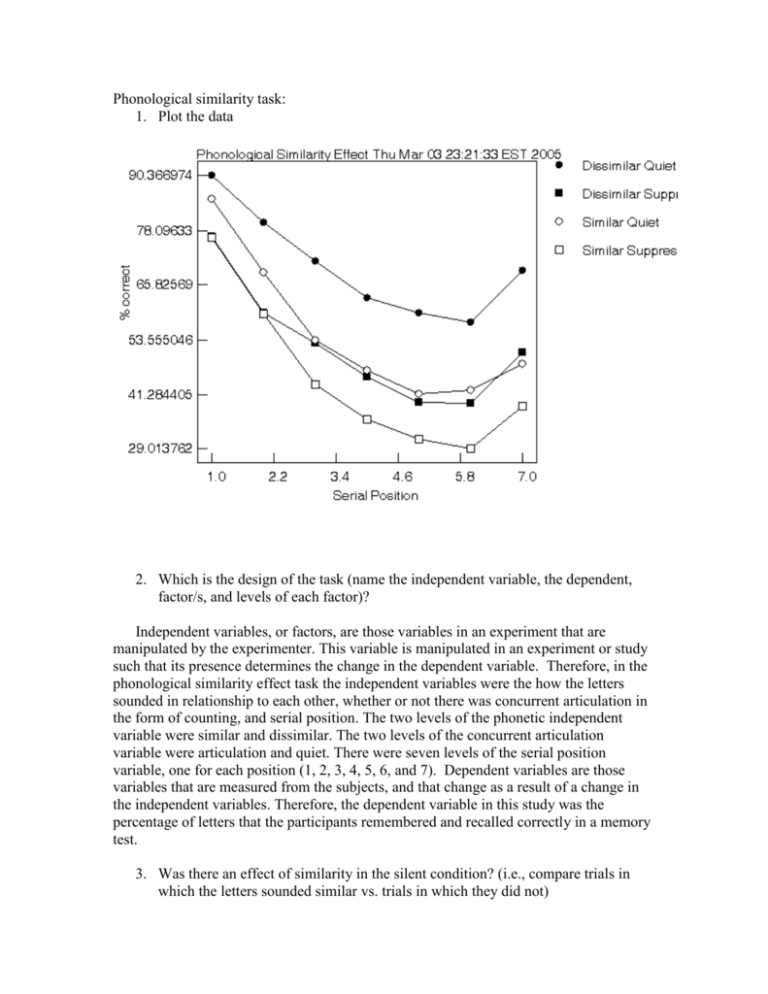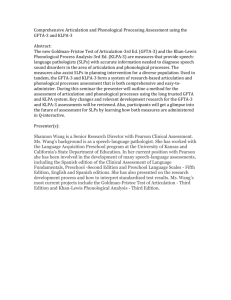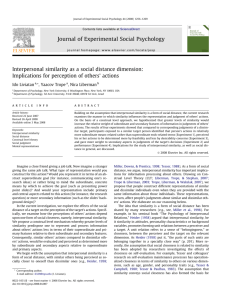Liz Marino
advertisement

Phonological similarity task: 1. Plot the data 2. Which is the design of the task (name the independent variable, the dependent, factor/s, and levels of each factor)? Independent variables, or factors, are those variables in an experiment that are manipulated by the experimenter. This variable is manipulated in an experiment or study such that its presence determines the change in the dependent variable. Therefore, in the phonological similarity effect task the independent variables were the how the letters sounded in relationship to each other, whether or not there was concurrent articulation in the form of counting, and serial position. The two levels of the phonetic independent variable were similar and dissimilar. The two levels of the concurrent articulation variable were articulation and quiet. There were seven levels of the serial position variable, one for each position (1, 2, 3, 4, 5, 6, and 7). Dependent variables are those variables that are measured from the subjects, and that change as a result of a change in the independent variables. Therefore, the dependent variable in this study was the percentage of letters that the participants remembered and recalled correctly in a memory test. 3. Was there an effect of similarity in the silent condition? (i.e., compare trials in which the letters sounded similar vs. trials in which they did not) In the silent condition, one would expect memory span for letters that sound similar to be shorter than memory span for letters that sound different. This is due to what’s referred to as the phonological similarity effect. Letters that sound similar create interference with each other when they are subvocally rehearsed. Therefore, it is easier to rehearse and remember letters that sound different than each other. I recalled 100 percent of the letters that sounded dissimilar in the silent condition and only about 88 percent of the letters that sounded similar. This result displays the phonological similarity effect, and can be seen by the negatively sloping upper line in the graph below (See question 4). 4. Was there an effect of similarity in the articulatory suppression condition? (If yes, was it larger or smaller than in the silent condition)? There was an effect of similarity even during the articulatory suppression condition. This effect can be seen in the graph below. Had there truly been no effect then the bottom line, marked by squares, would be horizontal rather than sloping downwards. The downwards slope indicated that similar sounding letters remained more difficult to remember while repeatedly counting to four. Phonological Similarity Effect 120 % Correct 100 80 quiet 60 articulation 40 20 0 dissimilar similar Sound However, theory suggests that similarity should not have little if any effect in the articulatory suppression condition. The reason for this is that if you somehow prevent the articulatory control process from converting the visual information to subvocal “sound”, then the phonological similarity effect will be removed and an individual’s ability to recall similar sounding and dissimilar sounding items will be equivalent. One way of preventing this recoding is to keep the articulatory control process busy doing something else such as repeatedly counting to four while trying to remember the letters.










